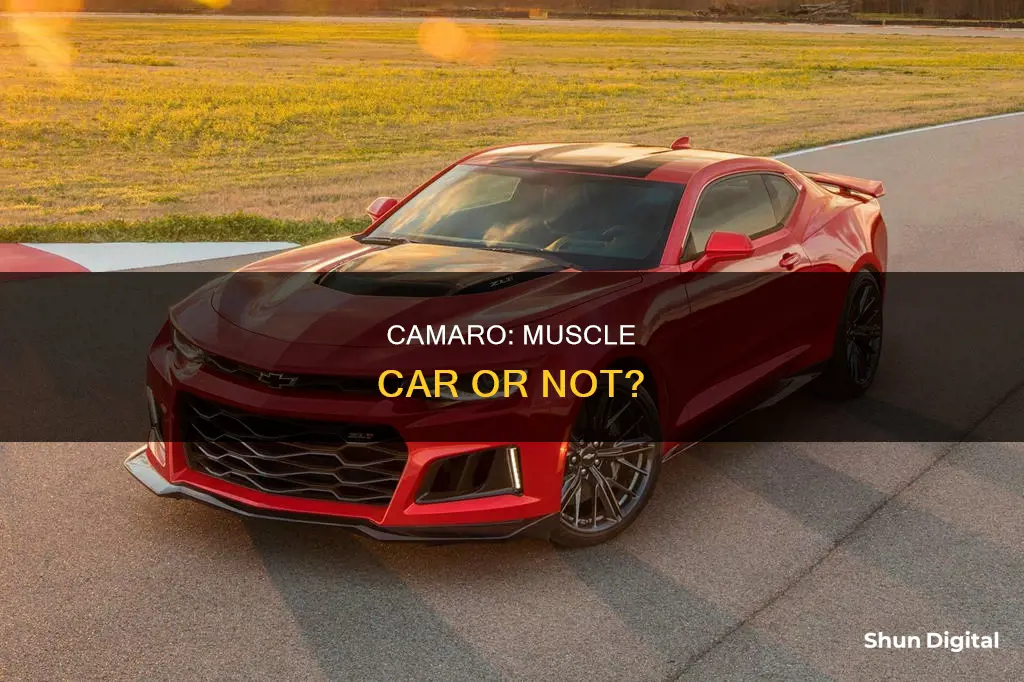
The Chevrolet Camaro is a car with a rich history and a dedicated following. Introduced in 1966 to compete with the Ford Mustang, the Camaro has evolved through six generations, each offering unique design and performance enhancements. But is it a muscle car? The answer is not so straightforward. Some enthusiasts consider the Camaro a muscle car, a symbol of American power and performance. Others view it as a sports car, praising its handling and agility. The Camaro's large coupe-like body and powerful engine options evoke the spirit of traditional muscle cars. However, its refined chassis dynamics and well-tuned suspension blur the lines, offering a driving experience that combines performance with handling, leading some to classify it as a sports car or even a sporty coupe. Ultimately, the definition of a muscle car may vary depending on individual perspectives and priorities.
| Characteristics | Values |
|---|---|
| First introduced | 1966 |
| Manufacturer | Chevrolet |
| Reason for introduction | To compete with the Ford Mustang |
| Engine | V8 |
| Type of car | Muscle car, Sports car, Pony car |
| Trim levels | LS/LT, RS, SS, ZL1 |
| Horsepower | 650+ |
| Acceleration | 0-60 mph in 3.5 seconds |
What You'll Learn

Camaro's muscle car status
The Chevrolet Camaro is often regarded as a muscle car, but its status as one is not universally agreed upon. Some enthusiasts consider it a sports car, a “sporty coupe”, or a hybrid of the two.
The Camaro was first introduced in 1966/1967 as a competitor to the Ford Mustang. It has since evolved through six generations, each offering unique design and performance enhancements. The first generation Camaro set the tone with its sporty look and powerful V8 engine—a feature that has become synonymous with muscle cars.
The term "muscle car" typically refers to a modestly-sized coupe powered by an oversized V8 engine capable of delivering straight-line thrills at an affordable price. The Camaro fits this description, especially with its V8 engine options in the RS, SS, and ZL1 trims. The ZL1, in particular, boasts over 650 horsepower and can go from 0 to 60 mph in just 3.5 seconds.
However, the Camaro also exhibits characteristics of a sports car. It handles and brakes exceptionally well, offering a driving experience that is both exhilarating and secure. Its suspension, steering, and braking capabilities surpass those of traditional muscle cars, which tend to focus solely on straight-line speed. Additionally, the Camaro's size and weight are often cited as factors that contribute to its sports car-like performance.
The Camaro's status as a muscle car or a sports car is further complicated by the fact that it offers a range of engine options, including a turbocharged four-cylinder engine that outperforms the V8s found in older muscle cars. This blurs the line between traditional muscle and modern performance, leading some to view the Camaro as a hybrid of both worlds or simply as a "sporty coupe".
Ultimately, the classification of the Camaro as a muscle car or a sports car depends on individual perspectives and interpretations of these car categories. Some enthusiasts embrace the Camaro as a symbol of American muscle car culture, while others view it as a dynamic sports car that handles far too well to be solely defined as a muscle car.
Kami Wire-Free Camera: How Long Does the Battery Last?
You may want to see also

Camaro's sports car status
The Chevrolet Camaro is often regarded as a muscle car, with its powerful V8 engine and rear-wheel-drive configuration. However, some enthusiasts also consider it a sports car due to its agile handling, well-tuned suspension, and precise steering. This debate has sparked varied opinions among car enthusiasts, with some even arguing that the Camaro is both a muscle car and a sports car.
The Camaro's Muscle Car Credentials
The Camaro has been a symbol of American muscle since its inception in 1966. Designed as a direct competitor to the Ford Mustang, the Camaro has gone through six generations, each offering unique design and performance enhancements. The first generation (1967-1969) set the tone with its sporty look and powerful V8 engine, a defining characteristic of muscle cars. The Camaro's large engine and rear-wheel-drive configuration provide the classic muscle car experience of straight-line speed and acceleration.
The Case for Sports Car Status
While the Camaro has the power and attitude of a muscle car, its handling and performance dynamics blur the lines. The Camaro's well-tuned suspension, precise steering, and high-performance brakes offer a driving experience that is both exhilarating and secure, traits commonly associated with sports cars. Additionally, the Camaro's size and weight are more in line with sports cars, with some arguing that it is too nimble and handles too well to be solely classified as a muscle car.
The Unique Blend of Muscle and Sports Car Characteristics
Some enthusiasts argue that the Camaro transcends traditional categories and is a unique blend of both muscle and sports car characteristics. The Camaro's powerful engine and muscular styling evoke the spirit of classic American muscle cars, while its handling, braking, and agility rival those of dedicated sports cars. This combination of muscle car power and sports car dynamics makes the Camaro a versatile performer that can cater to a wide range of driving preferences.
The Subjectivity of Car Classification
Ultimately, the classification of the Camaro as a muscle car, a sports car, or both, depends on individual perspectives and priorities. Muscle cars and sports cars have evolved over time, and the lines between them have blurred. The Camaro's ability to straddle these categories showcases its versatility and appeal to a diverse range of enthusiasts. Whether one chooses to label it as a muscle car, a sports car, or both, the Camaro remains an iconic performance vehicle with a rich history and a dedicated following.
Motorola Cameras: Where Are They Manufactured?
You may want to see also

Camaro's evolution through generations
The Chevrolet Camaro is a mid-size American automobile that has evolved through six generations since its inception in 1966. Designed to compete with the Ford Mustang, the Camaro has become an iconic muscle car known for its power and performance. Here is an overview of the Camaro's evolution through the generations:
First Generation (1967-1969):
The first-generation Camaro debuted in September 1966 and was produced for three model years. It featured a sporty look and a powerful V8 engine, with a base engine of 3.8L inline-6 and various V8 options. The first generation set the tone for the Camaro's performance and style.
Second Generation (1970-1981):
The second-generation Camaro was introduced in February 1970 and saw a dramatic design change. It became larger and wider while retaining the F-body platform. The 1980 and 1981 Z28 models included an air induction hood scoop, enhancing performance.
Third Generation (1982-1992):
The third-generation Camaro introduced modern fuel injection systems and offered improved technology. This generation was nearly 500 pounds lighter than its predecessor and featured updated transmissions and engine options.
Fourth Generation (1993-2002):
The fourth-generation Camaro refined the design and performance further. It retained the coupé body style and rear-wheel drive, offering a range of engine options, including a 3.4L V6 and a 5.7L V8. The SS version, introduced in 1996, featured a more powerful engine and improved suspension.
Fifth Generation (2010-2015):
The fifth-generation Camaro revived the classic Camaro look with modern technology. It was based on the 2006 Camaro Concept and featured styling cues from the 1969 Camaro, such as the grille, roof styling, and quarter windows. This generation marked the return of the convertible body style and offered improved engine options.
Sixth Generation (2016-2024):
The sixth-generation Camaro was introduced in 2015 for the 2016 model year. It featured a new platform shared with the Cadillac ATS and weighed 200 pounds less than its predecessor. The Camaro continued to offer a range of engine options, including a turbocharged inline-four, a V6, and a powerful V8. The ZL1 model, introduced in 2018, became a supercar beater with its supercharged V8 engine and improved aerodynamics.
Unlocking Creative Photography with the Sports Mode
You may want to see also

Camaro's trim levels and features
The Chevrolet Camaro, an iconic American muscle car, has been a symbol of power and performance since its inception in 1966. The Camaro offers a variety of trim levels, each tailored to different tastes and budgets.
The main trims include:
LS/LT: These are the base models, usually equipped with a V6 engine, offering a balance of performance and efficiency. The LS/LT trims are perfect for those seeking a stylish daily driver without compromising on power.
RS: The RS is a sportier version of the LS/LT, with enhanced aesthetics and suspension. It offers a more dynamic driving experience while still maintaining the practicality of a daily driver.
SS: The SS trim is for those who crave high performance. Equipped with a powerful V8 engine, the SS delivers an exhilarating driving experience with enhanced speed and acceleration.
ZL1: The ZL1 is the top-of-the-line model and the ultimate performance Camaro. Featuring a supercharged V8 engine, the ZL1 produces over 650 horsepower and can go from 0-60 mph in just 3.5 seconds. This trim is for enthusiasts who want the ultimate blend of power and handling.
Each trim level offers various packages and options, allowing buyers to customise their Camaro to their preferences. Features like touchscreen infotainment systems, Apple CarPlay, Android Auto, and advanced driver assistance technologies are common across most trims.
The Camaro's interior offers a sporty aesthetic while also providing comfort and practicality. Higher trim levels include premium features such as leather upholstery, heated and ventilated seats, and an intuitive infotainment system. However, like many muscle cars, the Camaro has limited rear seat and trunk space.
With its range of trim levels and engine options, the Chevrolet Camaro offers something for every type of enthusiast. Whether you're seeking a stylish daily driver or a track-ready performance machine, the Camaro's blend of American muscle, performance, and style is sure to impress.
Charging Your Nikon: A Quick Guide to Powering Up Your Camera 3700
You may want to see also

Camaro's competitors
The Chevrolet Camaro has had several generations, each with its own unique design and performance enhancements. The Camaro's direct competitors are the Ford Mustang and the Dodge Challenger.
Ford Mustang
The Mustang offers a similar range of engines, including a high-performance Shelby GT500. The Mustang tends to have a more comfortable interior and a slightly better balance between performance and daily usability. The Mustang is also more agile than the Camaro, but the Camaro has the edge when it comes to performance.
Dodge Challenger
The Challenger stands out for its larger size, offering more interior space and a more comfortable ride. It also offers a range of powerful engines, including the supercharged Hellcat and Redeye models. The Challenger is heavier than the Camaro and has a more retro design.
Other competitors to the Camaro include the BMW 4-Series, the Nissan 370Z, and the Acura, Alfa Romeo, Audi, and Buick models. The Camaro's unique blend of American muscle, performance, and style makes it a standout choice in a highly competitive market segment.
Dummy Battery Camera: What's the Deal?
You may want to see also
Frequently asked questions
The Camaro is considered by many to be a muscle car, but some disagree. The Chevrolet Camaro, which was first introduced in 1966, has been a symbol of power and performance and is considered an iconic American muscle car.
A muscle car is traditionally a modestly-sized coupe powered by an oversized V8 engine that delivers straight-line thrills at an affordable price.
The Ford Mustang, the Dodge Challenger, and the Chevrolet Camaro are considered the holy trinity of modern muscle cars.







